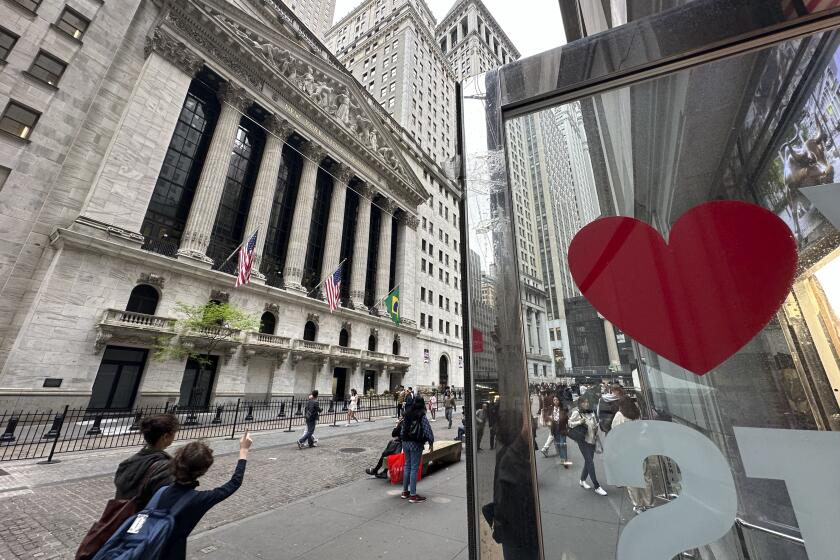Dollar Slumps on Investor Unease
The dollar slumped Thursday amid growing investor uneasiness over the speed and strength of the U.S. economic recovery.
Gold rose to a two-year high, in part on concerns about the dollar’s weakness and on renewed jitters over oil supplies.
Stocks closed mixed on Wall Street, with most indexes little changed, on fairly heavy volume.
The Dow Jones industrials gained 4.63 points to 10,035.06, and the Nasdaq composite inched up from Wednesday’s 51/2-month low, adding 0.36 point to 1,713.70.
The dollar took center stage on world markets, falling to a 31/2- month low against the euro, the Canadian dollar and the British pound, among other currencies. It also fell to a six-week low against the Japanese yen.
Recent economic data have been spotty. The government Thursday said workers’ wages and benefits rose at the slowest pace in three years in the January-to-March quarter. Reports Wednesday showed sales of new homes slowing and a decline in durable goods orders in March.
“It shows an economy that is in recovery, but it is a tentative one,” said Mark Zandi of Economy.com in West Chester, Pa.
A country’s currency typically reflects global investors’ faith in the economy. A strong currency often means foreigners are eager to buy a country’s assets, such as stocks. A weak currency can mean foreigners are selling those assets and taking their money elsewhere.
“U.S. stocks and bonds don’t look particularly good. It just seems we are in a bit of a period of uncertainty, and it looks like some of the long-dollar positions are starting to be cut,” said Ralph DelZenero, senior trader at Bank One.
The euro’s value rose to 89.8 cents, up from 89.2 cents Wednesday and the highest since early January.
The yen appreciated to 128.63 per dollar from 129.64 on Wednesday.
Although the dollar’s weakness so far is not severe--especially considering how strong the currency has been in recent years--analysts are concerned because the massive U.S. current-account deficit shows how dependent the country is on foreign financing.
In commodity trading, near-term gold futures in New York jumped $3.80 to $308.10 an ounce, a two-year high. Gold’s price is up from $279 at year-end.
Near-term crude oil futures added 35 cents to $26.73 a barrel after rising as high as $27.20 on concerns that Saudi Arabia may threaten to use oil as a weapon to push the U.S. to rein in Israel.
On Wall Street, the Dow industrials traded below 10,000 for much of the day but rallied in the last hour. The index last closed below 10,000 on Feb. 22.
Winners topped losers by 16 to 15 on the New York Stock Exchange, though losers had a 19-to-16 edge on Nasdaq.
The Treasury bond market did not appear shaken by the dollar: Long-term yields fell, with the 10-year T-note dropping to 5.09% from 5.11% on Wednesday.
Among Thursday’s highlights:
* Brokerage stocks slumped on fresh concerns about state and federal investigations of the industry’s practices. Merrill Lynch slid $2.15 to $42.50, Goldman Sachs lost $2.28 to $77.21, and Lehman Bros. dropped $2.24 to $57.91.
* Some technology stocks rebounded from their recent slide. Microsoft added 71 cents to $53.73. Corning gained 23 cents to $6.83.
* Gold stocks were mixed despite bullion’s gain. Barrick Gold rose 31 cents to $19.51, but Agnico Eagle fell 70 cents to $14.20.
* HMO stocks continued to surge amid strong industry earnings. WellPoint Health jumped $3.36 to $74.84; UnitedHealth added $1.01 to $87.
Market Roundup, C6-7
*
(BEGIN TEXT OF INFOBOX)
Daily Diary
(text of infobox not included)






